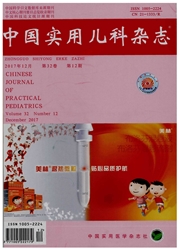

 中文摘要:
中文摘要:
目的 探讨蒙古族与汉族新生儿呼吸窘迫综合征(NRDS)的肺表面活性物质蛋白B(SP-B)基因外显子7突变特点。方法 采用前瞻性研究方法,选择2013年6月至2015年6月内蒙古医科大学附属医院新生儿科收治的85例NRDS患儿(病例组),其中汉族55例、蒙古族30例。选择同期84例非NRDS患儿为对照组,其中汉族58例、蒙古族26例。两组均采血样提取DNA,应用PCR基因分析技术对候选基因SP-B外显子7进行全测序。比较两组不同民族SP-B外显子7测序结果。结果 两组性别、胎龄、出生体重、出生方式、是否规律促肺成熟等差异均无统计学意义(P>0.05)。病例组和对照组SP-B基因外显子7全测序均未发现基因突变。结论 本研究病例未发现存在SP-B基因外显子7突变;未发现SP-B基因外显子7在内蒙古地区蒙汉民族之间存在差异。
 英文摘要:
英文摘要:
Objective To investigate the characteristics of SP-B gene exon 7 mutation of neonatal respiratory distress syndrome(NRDS) in the Han nationality and the Mongol nationality. Methods The prospective study method was used. Eighty-five infants with NRDS(the NRDS group) and eighty-four infants without NRDS(the control group) were selected as the research objects in June 2013- June 2015 in Inner Mongolia Medical University-Affiliated Hospital. In these cases, there were 55 cases with RDS(the NRDS group) and 58 cases without RDS(the control group) in the han nationality; in the Mongol nationality there were 30 cases with RDS(the NRDS group) and 26 cases without RDS(the control group). We extracted DNA and PCR gene analysis was used to detect candidate genes on exon 7 of SP-B. Results Between the NRDS group and the control group of children, gender, gestational age, birth weight, birth way and whether to promote lung mature regularly had no significant correlation (P〉0.05). Gene mutations were not found on exon 7 of SP-B in these two groups. Conclusion There is no mutation on SP-B gene exon 7 in this study.There is no difference on SP-B gene exon 7 between the Mongolian and the Han nationality in the Inner Mongolia area.
 同期刊论文项目
同期刊论文项目
 同项目期刊论文
同项目期刊论文
 期刊信息
期刊信息
